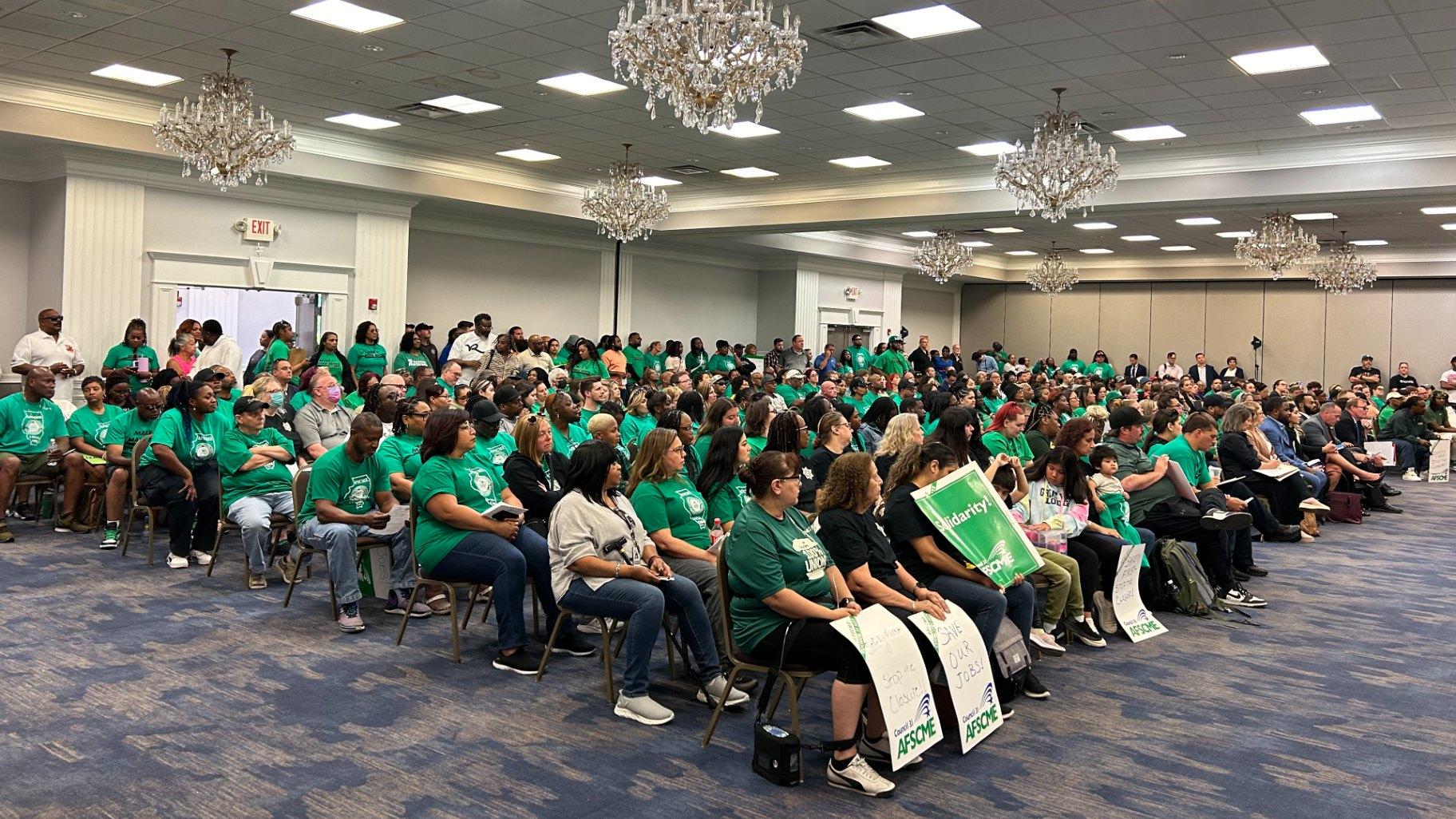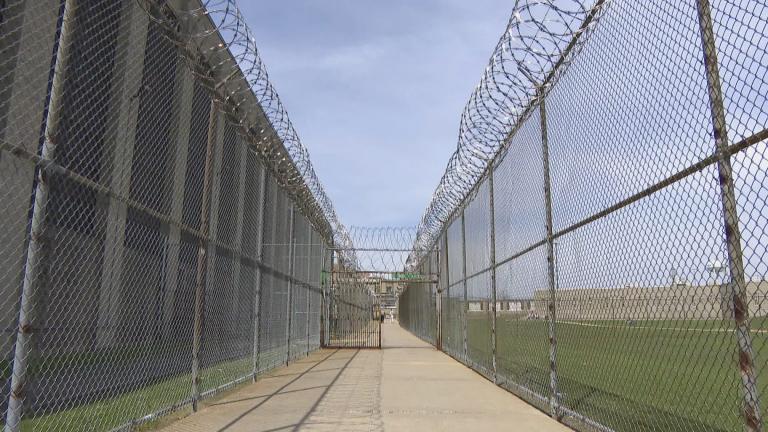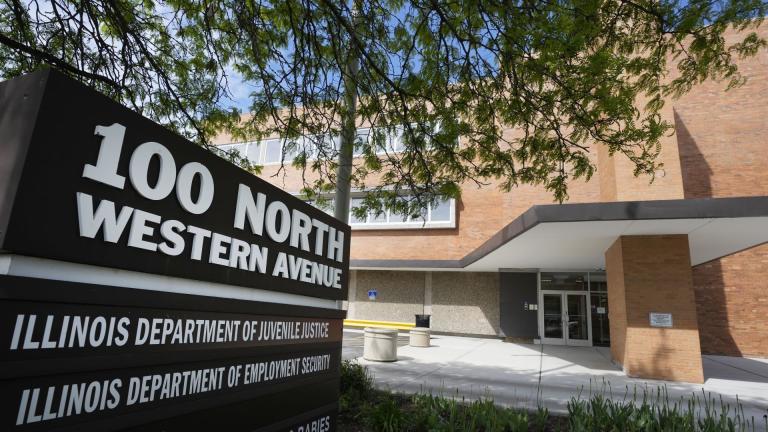 A crowd dominated by AFSCME members gathered on June 11, 2024, to voice opposition to the closure of Stateville Correctional Center. The union represents most employees of the Illinois Department of Corrections. (Blair Paddock / WTTW News)
A crowd dominated by AFSCME members gathered on June 11, 2024, to voice opposition to the closure of Stateville Correctional Center. The union represents most employees of the Illinois Department of Corrections. (Blair Paddock / WTTW News)
A sea of green AFSCME shirts dominated a packed hotel ballroom in Joliet. Members held signs reading “safety first–stop the closure” and “save our jobs.”
“Everyone you see back here is my family,” said Stateville Correctional Center employee Dorsy Peldonia.
Hundreds of people gathered Tuesday night to try to sway a vote by the Commission on Government Forecasting and Accountability (COGFA) over Gov. J.B. Pritzker’s administration’s recommendation to close and rebuild Stateville.
Officials announced they’re estimating the rebuild will about double the prison’s capacity, which it is already not fully utilizing.
The current rebuild design plan for Stateville is estimated to have a 1,500-person capacity, according to Illinois Department of Corrections Acting Director Latoya Hughes. She said it’s an “estimate as it relates to cost.”
That’s a sharp rise from the now 850-person rated capacity for the prison. And currently, only about 430 individuals are housed there, according to IDOC officials. In a statement, IDOC said, “The final capacity figure and building design implemented will be based on the culmination of the Department’s ongoing discussions with various stakeholders.”
In response to a question from WTTW News, the department said it will not have estimated staffing figures until the designs are complete and collective bargaining has concluded.
When asked whether she expects the population of the facility to grow beyond its current 50% capacity, Hughes responded yes. The new capacity estimate was “not developed in a way that was anticipating any other facility feeding into it,” she added.
Latoya Hughes, acting director of the Illinois Department of Corrections, sits in the crowd at a public Commission on Government Forecasting and Accountability hearing in Joliet on June 11, 2024. (Dilpreet Raju / Capitol News Illinois)
“I don’t understand the 1,500 when … there is so much excess capacity,” said Jenny Vollen-Katz, executive director of prison watchdog group the John Howard Association. “The numbers don’t make sense to me.”
Stateville, a men’s prison in Crest Hill, and Lincoln’s Logan Correctional Center, one of the state’s two women’s prisons, have been proposed for closure and rebuild. This hearing, and a Thursday hearing in Lincoln over Logan, is part of COGFA’s facility closure process.
“The repairs within the interior and exterior of the quarterhouse would require the department to depopulate [Stateville] during the construction for the safety and security of the individuals in custody, the staff and the contractors,” Hughes said.
On Friday, COGFA will hold an advisory vote on the proposed closure of both facilities. From there, the Pritzker administration makes the final decision; the recently passed 2025 fiscal year budget includes $900 million for capital investments to rebuild Stateville and Logan correctional centers.
It’s proposed that Stateville could be closed by September. Meanwhile, while Logan’s new facility is being built, the existing prison in Lincoln will remain open. IDOC officials said they estimate ground will not be broken for Stateville for about a year. Plus, it’s been suggested that Logan will reopen in Will County, moving from its current central Illinois location.
Those with stake in the matter largely agree that these facilities are uninhabitable for incarcerated people and that there should be more transparency from the Illinois Department of Corrections in the process.
But questions for the path forward are where people differ: Some incarcerated people miserable in current conditions are confused as to where they’ll be transferred, workers are concerned about where their jobs will go, and some advocates are questioning the idea of rebuilding the prison.
“I hear a lot of agreement. I don’t hear anybody standing up to keep the status quo,” said public commenter Susan Lucci, who recently visited Stateville. “I am also concerned about the timeline and any decision made without consulting those 420 humans in there.”
The department anticipates the rebuild of Stateville will take about five years and cost up to an estimated $425 million. Building housing units makes up the bulk of that estimation, with officials saying it could range from $170-$215 million. Officials also have the goal of making the new facility focused on rehabilitation and education, which takes up the next largest chunk of estimated costs, at $35-$75 million.
“We are here today to emphasize that the urgent need to act now drives the administration’s decision to close and rebuild Stateville rather than to repair it,” Hughes said. “The current living conditions at Stateville are not conducive to rehabilitation.”
The governor announced the prison closure plan in March, 10 months after the administration received a report it had commissioned on the deferred maintenance of state prisons.
That report found that Stateville is “not suitable for any 21st century correctional center.”
Inside, the report said, incarcerated people are in “very poor” cramped housing; the 100-year-old design is reflective of 1800s prison philosophy. Shower facilities are poor and create issues under the Prison Rape Elimination Act. There’s also peeling paint, leaking roofs and extension cords that run from cell to cell due to limited electrical connections.
It’s the third oldest building in IDOC, having opened in 1925. The historically maximum security prison sits on about 2,000 acres.
The property also houses the Northern Reception and Classification Center, which is the major adult male intake and processing unit for the entire state, as well as a minimum security unit. Both will stay open throughout the construction.
James Soto was housed at Stateville for 21 years up until his exoneration last year after being wrongfully convicted and imprisoned for a total of 42 years. He said he recently took a blood test that found elevated levels of lead in his system caused by the drinking water, which advocates have raised the alarm bell on over the years.
“I’m in favor of rebuilding Stateville, but to close it completely [in the interim],” Soto said.
Jimmy Soto, who spent more than 42 years wrongfully incarcerated in state prisons, speaks to the Commission on Government Forecasting and Accountability at a public hearing in Joliet on June 11, 2024. (Dilpreet Raju / Capitol News Illinois)
Lucci said she recently spoke to men incarcerated at Stateville who are terrified about their uncertain future.
Transfer locations of incarcerated people at Stateville will be decided by individualized assessments including people’s medical, mental health or program needs, according to the department.
AFSCME Council 31, the union that represents most employees within the Department of Corrections, supports building a new facility at Stateville Correctional Center, but strongly opposes closing the current facility before the new one is built in part for concerns about longer commutes and losing jobs.
Charles Mathis, a Stateville employee of nine years, said while he’s for rebuilding the prison, he’s concerned that he’ll have to travel farther for work. He said he’s already traveling 45 minutes “on a good day” from the South Side of Chicago to the prison. If he’s transferred to work at Pontiac Correctional Center, for example, it could add about an hour to his commute.
“That kind of commute round trip will take an enormous toll on my mind and body,” Mathis said.
IDOC has stated it does not expect that any employee will lose state employment as part of the process. As of March 31, Stateville employed a total of 939 staffers, with 676 security personnel and 263 non-security employees, according to the department.
IDOC said if current staffing patterns hold, the department estimates approximately 1,000 IDOC positions available within a 65-mile radius of Stateville. Officials said most security employees will be absorbed by the Northern Reception and Classification Center on Stateville’s current property.
There are other opportunities at facilities like the Joliet Treatment Center with 268 vacancies, Pontiac Correctional Center with 506 vacancies and Sheridan Correctional Center with 169 vacancies, according to officials.
IDOC officials said that Stateville employees transferred to other facilities during rebuilding will have first rights to work at the new facility upon reopening.
State Rep. C.D. Davidsmeyer, R-Jacksonville, co-chair for the Commission on Government Forecasting and Accountability, listens to public testimony in Joliet on June 11, 2024. (Dilpreet Raju / Capitol News Illinois)
Mike Newman, deputy director of the union, said the timeline, especially the possible September closure, is rushed. He and other members want Stateville to stay open during construction, as is the plan for Logan. He said there are critical pieces of information missing, like design plans for the future sites.
“The extremely rushed closure timeline should be slowed to ensure that there are sound answers to the many questions raised during this COGFA process,” Newman said. “And for that reason alone, this commission should not approve this plan.”
Matthew Zematis, who works in Stateville’s education building, is concerned about the future of the prison’s educational programs. It’s become a site of robust opportunities, like Northwestern University providing a chance to earn bachelor’s degrees or the Prison + Neighborhood Arts/Education Project connecting teaching artists to incarcerated students.
“Any closure of Stateville, even over a short period of time, will harm these individuals because no other facility can provide this,” Zematis said.
Christina Rivers, director of DePaul University’s Institute for Restorative Educational Engagement, said the group doesn’t have the staffing to move its programs farther than Sheridan.
“At one point, [Illinois River Correctional Center] was discussed with us,” Rivers said. “That three and a half hours away, it would kill our programming to be honest, especially because we bring in so many outside students and coordinating the rides and getting the vans.”
A COGFA hearing over the proposed closure of Logan will be held at 5 p.m. Thursday at Lincoln Junior High School, 208 Broadway St. in Lincoln.








